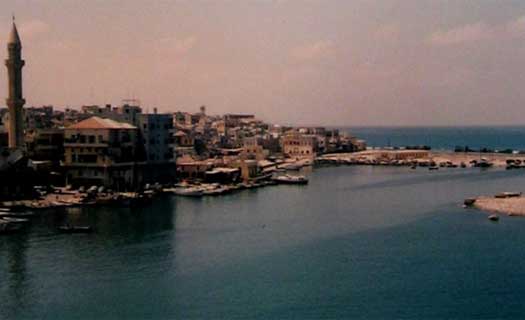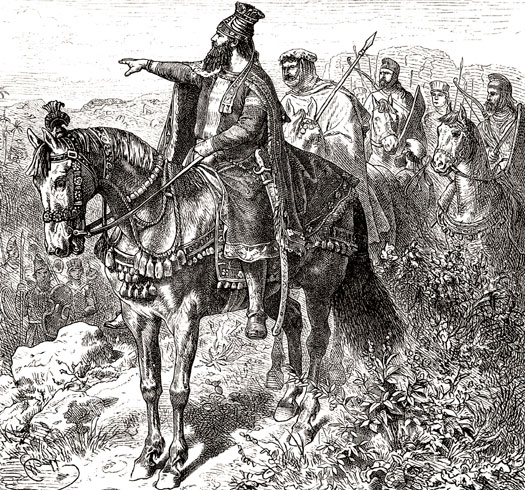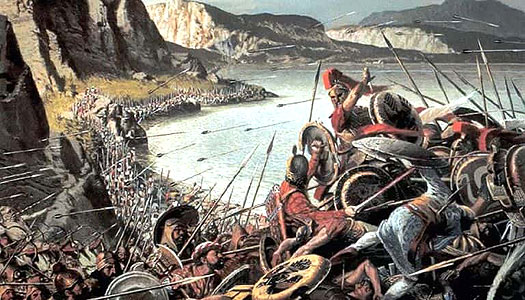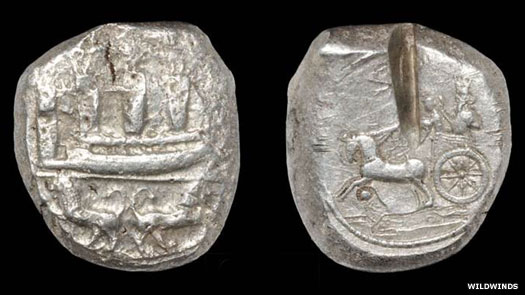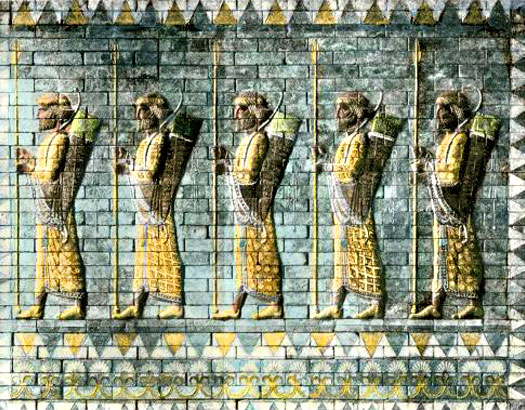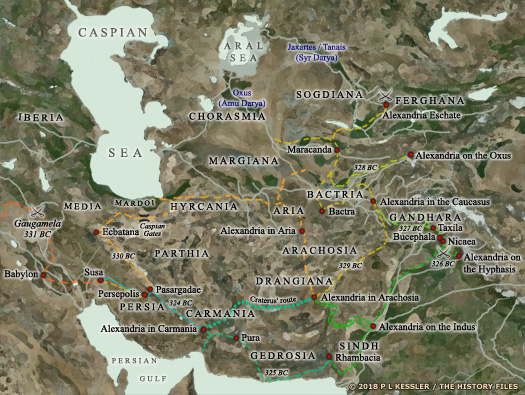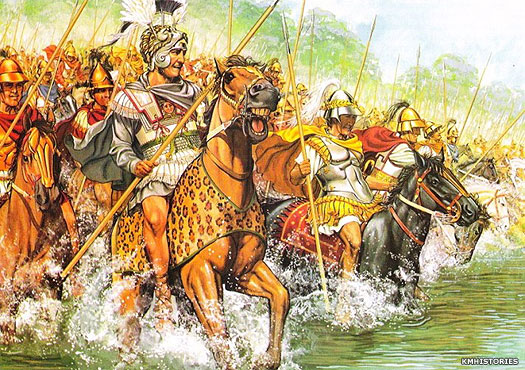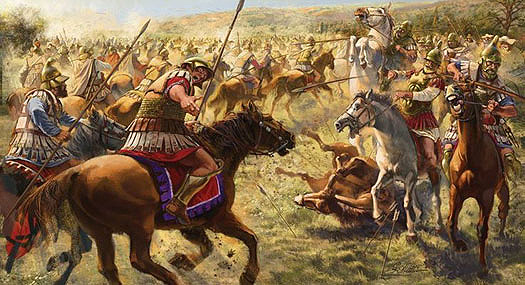
| SIDON Inhabited from about 4000 BC (and perhaps as early as the Neolithic age in 6000 BC), the name of this coastal city means 'fishery'. Claimed by many to be the oldest of the Canaanite or Phoenician cities, it vies with Gebal for that honour.
Sidon is located in modern Lebanon, about 40km (25 miles) north of Tyre and the same distance south of Biruta, and is now its third-largest city, a busy port called Saydah. For the reason that it is still occupied, archaeological research of the Canaanite city is very difficult, so its history is pieced together from what records remain, plus what digs can be carried out during any rebuilding or construction projects.
c.2000 - 1800 BC :
Egypt maintains a trading presence in the region.
18th cent BC :
Zimrida
1453 BC :
The Egyptians conquer the Levant and Syria and establish three provinces in their conquered territories which are named Amurru (in southern Syria), Upe (in the northern Levant), and Canaan (in the southern Levant). Each one is governed by an Egyptian official. Native dynasts are allowed to continue their rule over the small states, but have to provide annual tribute. The city of Sarepta is a vassal of Sidon by this time.
1300s BC :
Zimr-Hadda / Zimrida II
1300s BC :
Iab-nilud
c.1200 BC :
There is general collapse in the region as instability grips the Mediterranean coast and the Hittite empire is destroyed by the Sea Peoples and other various groups. Arvad, Gebal, Sidon, and Tyre, all with prominent harbours, manage to survive unscathed, although the wealthy customers disappear for a time.
Phoenician Sidon :
Claimed by many to be the oldest of the Canaanite or Phoenician cities, the city of Sidon vies with Gebal for that honour. Its name means 'fishery', making pretty obvious the original reason for settlement here. Sidon was for a long time highly influential, but was later surpassed in this respect by its colony at Tyre. Descended from the Canaanites who formerly inhabited the entire Levant region, Phoenicians still thought of themselves as Canaanites even after their greatest days were behind them, and their language was very closely related to ancient Hebrew. It was the Greeks who coined the name Phoenicia ('phoinikes', meaning 'purple people', from the famed purple dye they produced from the shells of the Murex shellfish). Unfortunately, one technological advance during the city's greatest independent period was the use of parchment and papyrus instead of clay tablets for record-keeping. These are highly perishable, and few have survived.
In the first millennium BC, Sidon, on the long coastal strip of modern Lebanon, was one of the most important Canaanite cities in Phoenicia. It was partly responsible for creating the great commercial empire which operated from the Lebanese coast. It was also from Sidon that a party went out to found the city of Tyre, and the two later became rivals, with each of them claiming to be the mother city of Phoenicia.
The Greeks knew Sidon as the home of the Princess Europa, whom Zeus supposedly abducted while disguised as a white bull. Sidon's most important industry was glass-making, which was conducted on a vast scale, and the production of valuable purple dye. All of the Phoenician cities were great seafaring merchants with technically improved ships that had a large loading capacity. They sailed the length of the Mediterranean and beyond, establishing colonies in North Africa and Spain from the tenth century onwards.
(Additional information from External Link: An Updated Chronology of the Reigns of Phoenician Kings during the Persian Period (539-333 BC), Josette Elayi (Trans 32, 2007, available in English at DigitOrient).)
c.1050 BC :
A weakened Egypt loses its remaining imperial possessions in Canaan.
c.955 BC :
According to the Old Testament, the First Temple of Jerusalem is completed in Israel, apparently by craftsmen from Sidon. Soloman also enters into a matrimonial alliance with Sidon, but Sidon's influence is already waning as Tyre gains pre-eminence in Phoenicia, and it may well be that it is already controlled by Tyre. Any list of rulers for the city in this period invariably shows names of kings who are based in Tyre.
853 BC :
An alliance of states is formed which includes Ammon, Arvad, Byblos, Damas, Edom, Egypt, Hamath, Kedar, and Samaria (seemingly despite recent conflict between Damas and Samaria). Together they fight Shalmaneser III of Assyria at the Battle of Qarqar which consists of the largest known number of combatants in a single battle to date, and is the first historical mention of the Arabs from the southern deserts. Despite claims to the contrary, the Assyrians are defeated, since they do not press on to their nearest target, Hamath, and do not resume their attacks on Hamath and Damas for about six years.
738 BC :
All of the Phoenician states become vassals of Assyria, but local arrangements for governance are left in place.
722 BC :
Shalmaneser's invasion allows Tyre to gain possession of Sarepta.
704 - 701 BC :
With the death of Sargon II of Assyria, many of the former subject states rebel. It takes the Assyrians until 701 BC to get around to quelling the Phoenician states. Tyre and Sidon fall without a fight, and the cities in their orbit surrender.
The port of Sidon, one of the principal ports on the Phoenician coastline c.685 - 677 BC :
Abdi-Milkuti : Last-known Sidonian king, under Assyria.
676 - 612 BC :
Assyria conquers all of Phoenicia. In Sidon, subject kings may be allowed to remain in power, at least during the later stages of Assyrian rule, although their names are unknown. However, as Tyre appears to lose its ability to control events in the city, it seems likely that the two cities no longer share the same rulers.
600s - 573 BC :
Tyre regains control over Sidon.
573 - 539 BC :
Babylonia conquers Phoenicia including Sidon.
539 BC :
Sidon and all of Phoenicia is submerged within the Persian empire. Vassal kings are allowed to remain in charge in the city.
Persian & Greek Vassal Kings of Sidon :
Like the other Phoenician cities, at its height Sidon had founded colonies along the western Mediterranean coastline, especially in North Africa and Spain from the tenth century BC onwards. The city lies about forty kilometres north of Tyre and the same distance south of Biruta. Independence ended in 738 BC when Assyria invaded and conquered the Levant. Local arrangements for governance were generally allowed to continue, however, setting a pattern for subsequent domination by Babylonia, Achaemenid Persia, and the Greek empire of Alexander the Great. One of the main reasons for this, especially under the Persians, was that it was the Phoenicians who made up much of the empire's naval forces, both building and manning the ships.
As part of the Achaemenid empire Sidon was one of the four Phoenician vassal 'kingdoms' to be established and controlled by sub-kings in the name of the Persian king. This took it out of the control of the shoftim of Tyre (if that city had been able to apply any control after 573 BC), and gave it more independence and influence than it had enjoyed for centuries. Sidon became prominent in the region until the revolt of 358 BC, although not to the point at which it could dominate the other major Phoenician cities. It did command some smaller ones though, such as Dor and Sarepta. Overall, Achaemenid-era Phoenicia formed part of a large satrapy which was commanded from Babirush (Babylon) and which included Ebir-nāri (Syria). Later Achaemenid Syria and Phoenicia seem to have been established as a single satrapy in their own right, away from oversight by Babylon. Ebir-nāri dominated this arrangement, with a capital that was probably at Damascus or Sidon.
The political system for the cities under Persian rule can only be reconstructed at its most basic level, so there are still many unanswered questions about this period. Even the chronology for the city's kings has undergone much rewriting in the past few decades as new evidence has been unearthed. Previously, King Eshmun'azar II was placed around the 490s BC, while now a date around 525 BC seems more realistic. Sidon's kings kings dressed in Persian style, issued coins with the head of the Persian king on them, and rebuilt the royal palace in the Persian style. They also supplied the Persian navy in various campaigns, along with Egyptians, Cypriots and Ionians, especially for campaigns in Mudrāya (Egypt) and Greece. When Greek domination of the region arrived in 332 BC in the form of Alexander the Great, Sidon welcomed him without offering any resistance.
Today's Sidon lies in Lebanon, its third-largest city, and is now a busy port called Saydah (the same ancient name filtered through post-Islamic Arabic). As it is still occupied, archaeological research of the early Canaanite city is very difficult. Instead its history has to be pieced together from what records remain, plus those archaeological digs that can be carried out during any rebuilding or construction projects.
(Information by Peter Kessler, with additional information from The Persian Empire, J M Cook (1983), from The Histories, Herodotus (Penguin, 1996), from The Cambridge Ancient History, John Boardman, N G L Hammond, D M Lewis, & M Ostwald (Eds), from Alexander the Great, Krzysztof Nawotka (Cambridge Scholars Publishing, 2009), from Jewish Antiquities, Flavius Josephus, from Alexander the Great, I Worthington (Routledge, 2004), and from External Links: Encyclopćdia Britannica, and the Nabonidus Chronicle, contained within Assyrian and Babylonian Chronicles, A K Grayson (Translation, 1975 & 2000, and now available via Livius in an improved version), and Encyclopaedia Iranica, and Ancient History Encyclopaedia, and The Role of the Phoenician Kings at the Battle of Salamis (480 BC), Josette Elayi (Journal of the American Oriental Society Vol 126, No 3 (Jul-Sep 2006), pp 411-418, available via JSTOR), and An Updated Chronology of the Reigns of Phoenician Kings during the Persian Period (539-333 BC), Josette Elayi (Trans 32, 2007, available in English at DigitOrient).)
c.575 - 550 BC :
Eshmunazzar / Eshmun'azar I : Dynasty founder.
c.549 - 539 BC :
Tabnit I : Son. Married sister, Amoashtart. Predeceased son's birth.
c.530s BC :
Amastoreth / Anysus : Son? A brief reign is suggested.
c.530s BC :
Some modern lists place Amastoreth here without supplying possible dates. However, prevailing understanding is that Tabnit rules for a relatively short time, dying before the birth of his son, Eshmun'azar II. His sister-wife then supplies a short regency period in which she rules alone prior to her son's arrival, and then acts as his regent until he reaches majority. Therefore the Amastoreth shown here could in fact be Amoashtart, the queen and regent.
Cyrus the Great freed the Indo-Iranian Parsua people from Median domination to establish an empire which included the Phoenician coastal towns of today's Lebanon (from 539 BC) c.530s - c.525 BC :
Eshmun'azar / Eshmun'azar II : Brother. 'King of the Sidonians'. Vassal to Persia.
c.530s - c.525 BC :
Amoashtart / Amashtart / Amastarte : Queen mother and regent during Eshmun'azar II's minority.
c.525 BC :
An otherwise unknown ruler of Sidon in this period, amongst a series of almost entirely obscure kings, the (originally Egyptian) sarcophagus of Eshmun'azar II is discovered in AD 1855, with the inscription 'King of the Sidonians' on the lid and a comment that his mother had been a priestess of Ashtart, 'the goddess of the Sidonians'. The inscription also confirms that both his parents are the offspring of his grandfather. He is around fourteen years of age at his death (during the reign of Cambyses of Persia), ruling almost entirely under the regency supplied by his mother.
The Persians conquer Mudrāya (Egypt) in 525 BC, creating the 27th Dynasty (the Behistun inscription of Darius the Great uses the name Mudrāya). With a navy that has been bolstered with Phoenician vessels, they add Cyprus to the empire in the same year, along with a host of Greek islands which are known collectively to the Persians (as recorded on the Behistun inscription) as Yauna (Ionia to the Greeks).
c.525 - 515 BC :
Bodashtart / Bodastart (I) : Cousin to Eshmun'azar II.
c.520 BC :
As a prolific builder and restorer of existing buildings in Sidon, Bodashtart leaves at least thirty inscriptions. Later examples in his reign carry the name of his son and chosen heir, Yaton Melik.
c.515 - 486 BC :
Yaton Melik / Yatonmilk : Son.
c.486 - 480 BC :
Anysos : Generally unknown apart from at Salamis in 480 BC. Killed?
480 BC : Invading Greece in 480 BC, the Persians subdue the Macedonians and the Thracian tribes (except for the Satrai, precursors to the Bessoi). Then the vast army of Xerxes makes its way southwards and is swiftly engaged by Athens and Sparta in the Vale of Tempe. The Persian army is held up long enough for the Athenians to prepare their navy for a seaborne engagement with the Persian fleet.
The Spartan stand at Thermopylae in 480 BC, along with some Greek allies, stopped the Persian advance in its tracks and provided a rallying call for the rest of the free Greek cities to oppose the Persians Athens, as the leader of the coalition of city states known as the Delian League, fights the Persian navy at the battles of Artemisium and Salamis, the latter being a resounding Greek victory. Tetramnestus, son of Anysos is present - along with Anysos himself (the Greek form of his name - the Phoenician form is unknown), and other leading Phoenicians such as Mattan IV of Tyre and Merbalos of Arvad - but the battle leaves much of the Persian navy destroyed and Xerxes is forced to retreat to Asia, leaving his army in Greece under Mardonius. The fate of Anysos is unknown, but it is possible that he is killed in one of the battles.
c.480 - 479 BC :
Tetramnestus / Tetramnestos : Son. Also at Salamis in 480 BC. Removed? Died?
c.479 - 450 BC :
There is an important gap here in the succession that cannot be rectified by adjusting the dates for either Tetramnestus or Ba'al Sillem (the same gap exists in Tyre's chronology). Sidon starts minting its coinage shortly after 450 BC (the Group III coinage of archaeological finds), while a new king appears roughly around the same time in the form of Ba'al Sillem (or Baalshillem). Group I and II coinage cannot be assigned to any king or kings with any certainty, but they do seem to represent two earlier dynasties. Presumably (but not proven) these cover Eshmunazzar I to Yaton Melik, and Anysos to Tetramnestus respectively.
Who rules Sidon in between the first two groups and the third is still a puzzle. A possible solution is provided by the fact that Sidon seems to serve for at least part of the Persian period as the capital of Ebir-nāri. With the satrap based here, the need for a king of Sidon may be seen as irrelevant, and seemingly so for the course of an entire generation.
Shown here are two sides of a coin which was minted in the mid-fifth century BC, which would make it one of the first such mints, under the reign of Ba'al Sillem I, first king of a new dynasty following a period of interregnum c.450 - 423 BC :
Ba'al Sillem I : His reign begins a different genealogy. In Tyre too?
fl c.423? BC :
Abdamon / Avdimon : Son. In Salamis (c.415 BC), Sidon & Tyre.
c.423 - 401? BC :
Baana : Son. Known from numismatic evidence.
401 BC :
Cyrus, satrap of Asia Minor, attempts to revolt, mobilising an army and ten thousand Greek mercenaries to attack his brother the Persian king. The king of Sidon is one of those who is responsible for mobilising naval forces for the subsequent campaign. Defeat for Cyrus leads to his death in October 401 BC at the Battle of Cunaxa. Fortunately Ba'al Sillem II begins dating his coinage from year thirty of his reign, in 372 BC, making the timeline here much more certain.
401 - 366 BC :
Ba'al Sillem II 'The Ship-Owner' : Son. With a nickname coined by Greeks.
c.415 BC :
The Phoenician ruler of Salamis is killed by Abdemon, who subsequently rules both Salamis and Tyre. Evagoras, who is a Cyprian Greek, is forced to leave the island at the same time, heading into exile on Soloi. Abdemon's role in Sidon seems brief, although the dates are far from conclusive. Possibly he hands the throne to his son in exchange for his own larger domain across the eastern Mediterranean.
365 - 352 BC :
Abdashtart / Abdiashirta / Straton I : Son. Related in some way to Eshmun'azar II. In Tyre?
after c.365 BC :
Justinus gives an account regarding a revolt of Tyrian slaves who seize power and then establish a King Abdashtart (Greek Straton) on the throne there. It is tempting to relate this event to the monetary series bearing Ṣ- / ṢR- for Tyre and the ☾ initial of the name Abdashtart (☾BD☾ŠTRT), the king chosen by the slaves. It cannot be a coincidence that Sidon already has a King Abdashtart (I) at this time.
359 BC :
At the end of a long revolt against Artaxerxes II, mainly by Phrygia, Khilakku, and Katpatuka, Abdashtart decides to rebel himself. He is supported by Takhôs, pharaoh of Egypt, who has already sent substantial support to the other rebels only to see them fail with the final Persian suppression of the satrapal revolt in this very year, 359 BC. The outcome of Abdashtart's own efforts is unclear, but they are probably minor as he remains on the throne.
These archers of Darius' Royal Guard were on display in the Hall of Artaxerxes II, whose continued efforts to break a long-running rebellion against him involved attempts to re-invade Egypt 351 - 347 BC :
Tabnit II / Tennes : Son or relative? Rebelled against Persia. Put to death.
346 BC :
Satraps Mazaeus of Khilakku and Bēlsunu of Ebir-nāri lead fresh contingents of Greek mercenaries to put down the revolt in the Levant. Phoenicia is attacked first (principally involving Sidon), but both satraps are repulsed. The Persian king himself is forced to follow up with a more direct intervention.
Tabnit (or Tennes to the Greeks) is leading the rebellion in Sidon - which includes the use of the city's naval fleet, which is normally at the disposal of the empire for external actions - but it is crushed in the same year and the city razed, partially thanks to Tabnit taking fright at the Persian response and betraying his own city (a stray Babylonian tablet speaks of the arrival in Babylon and Susa in late 345 BC of Sidonian captives and women for the palace). A replacement king in the form of Abdashtart has to rebuild the city, but it loses its regional pre-eminence and is militarily occupied for four years.
c.346 - 343 BC :
Bodashtart / Bodastart II : Invented through a misinterpretation of an inscription.
c.346 - 343 BC :
Evagoras (II) : Former king of Salamis. Persian vassal ruler.
c.346 BC :
The appearance here of Evagoras II former king of Salamis, is due to the abbreviation used on new coins in this period. The presence of Bodashtart II has been established as a misreading of an inscription by a single scholar and the name dismissed. Assigning Evagoras as the issuer of the new coins is far from certain at present, but he seems a very likely candidate. Presumably he is brought in by the Persians to act as military governor following the execution of Tabnit II for rebellion (Satrap Mazaeus of Khilakku and Ebir-nāri mints his own coins in Sidon during 353-333 BC).
342 - 333 BC :
Abdashtart / Abdiashirta / Straton II : Son of Ba'al Sillem II. Deposed for being a friend to Persia.
333 - 332 BC : In 334 BC Alexander of Macedon launches his campaign into the Persian empire by crossing the Dardanelles. Much of Anatolia falls by 333 BC and Alexander proceeds into Syria during 333-332 BC to receive the submission of Ebir-nāri, which also gains him Harran, Judah, and Phoenicia (principally Byblos and Sidon, with Tyre holding out until it can be taken by force).
Alexander the Great crossed the River Graneikos (or Granicus) in 334 BC to spark a direct face-off with the Persians that had been brewing for generations, while above that is a map showing the route of Alexander's ongoing campaigns, leading him from Europe to Egypt, into Persia, and across the vastness of eastern Iran The people of Sidon remove Abdashtart II (Straton to the Greeks) from power themselves as he is a friend of Darius. Athura, Gaza, and Egypt also capitulate (not without a struggle in Gaza's case). Sidon accepts Alexander, probably with some relief as the Persian retaliation of a dozen years earlier will still be an open wound. With Phoenicia having been taken, the region is governed from Tyre.
332 - 329? BC :
Abdalonymus / Abdalonim : King of Byblos, Sidon, & Tyre under the Greek empire.
329? BC :
The cities of Arados, Byblos, Sidon, and Tyre are incorporated into the satrapy of Syria within the Greek empire. Following the death of Alexander the Great in 323 BC, the latter three are largely dominated by Ptolemaic Egypt until 219-217 BC. The fate of Abdalonymus is unknown, with him not being mentioned after 329 BC.
c.316 - 287 BC : Little is known about Sidon in this period, or about its ruler. One Philokles, son of Apollodorus, seemingly provides staunch service to Ptolemaic Egypt, always appearing amongst forces that are arrayed in the region against the Antigonids during the Wars of the Diadochi. Despite the Greek-sounding names, both are almost certainly Phoenicians.
Philokles is attested as the 'King of the Sidonians' in an Athenian inscription of 286 or 285 BC. He is also listed as a benefactor - possibly in the late 310s - who has donated very generously towards the rebuilding of the city of Thebes following its having been razed by Alexander. The rebuilding is initiated by Cassander of Macedon in 316 BC. Such availability of funds makes him very important in terms of the Phoenician cities, possible a relative of at least one of the recent rulers.
The Battle of Ipsus in 301 BC ended the drawn-out and destructive Wars of the Diadochi which decided how Alexander's empire would be divided It may be this Philokles who is responsible for capturing the city of Kaunos in 309 BC for Ptolemy, by treachery, according to the second century AD writer, Polyaenus. The writer also refers to him as a 'general of Ptolemy'. The city is very soon lost again to the Antigonids but is again held, now by Philokles as king, from about 286 BC. His career (and reign) would appear to be in their twilight years by the time of his last mention in 279 BC. No details are known of any potential successor.
287? - 279? BC :
Philokles / Philocles : King of Sidon & Kaunos under Ptolemaic Egypt.
279 BC :
Phoenicia remains largely dominated by Ptolemaic Egypt until 219-217 BC, when the Fourth Syrian War sees Seleucid ruler Antiochus III fighting Ptolemy IV for control of their mutual border. Antiochus recaptures Seleucia Pieria, Tyre, and other important Phoenician cities and their Mediterranean ports, but is fought to a draw at Raphia on Syria's southernmost edge. The subsequent peace treaty sees all the gains other than Seleucia Pieria relinquished. Seleucid control is probably reconfirmed more permanently in 195 BC and remains in place until the mid-first century BC Roman takeover of the region.
Source :
https://www.historyfiles.co.uk/ |
